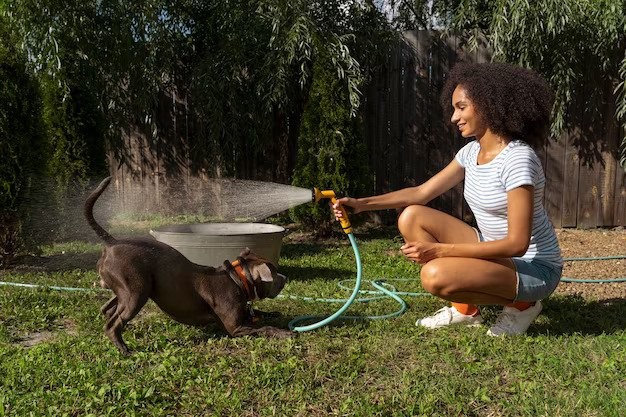Designing a Dog-Friendly Landscape: 8 Tips and Tricks

Table of Contents
Designing a dog-friendly landscape is a wonderful way to create an outdoor space where both you and your furry friend can enjoy the beauty of the outdoors.
However, it’s essential to consider the specific needs and behaviors of your dog while planning your landscape.
In this blog, we’ll provide you with valuable tips and tricks to help you create a safe, functional, and aesthetically pleasing outdoor environment for your canine companion.
1. Choose Pet-Safe Plants and Materials for Dog-Friendly Landscape
When designing a dog-friendly landscape, it’s vital to select plants and materials that are safe for your furry friend. Some plants can be toxic to dogs if ingested, so it’s crucial to do your research and opt for pet-friendly options.
Plants like lavender, sunflowers, and rosemary are excellent choices as they are non-toxic and add a delightful fragrance to your outdoor space.
Additionally, consider the type of materials you use. Avoid toxic mulch and opt for pet-safe alternatives. Gravel, rubber mulch, and untreated wood chips are good options. These materials are not only safe for your dog but also help with drainage and prevent muddy paws in wet weather.
Ensuring that your landscape is free from harmful plants and materials is a fundamental step in creating a safe outdoor environment for your pet.
2. Designated Play Areas
Dogs need space to run, play, and explore. Designating specific play areas in your landscape can help contain their activities and protect your plants and garden beds.
Installing a secure and visually appealing fence can create a designated play zone while keeping your dog safe and preventing them from wandering into areas where they shouldn’t be.
Incorporate features like agility equipment, digging pits, and toys in these play areas to keep your dog entertained. A well-planned play space not only benefits your pet’s physical and mental health but also prevents them from causing damage in other parts of the garden.
3. Pathways and Walkways
Dogs tend to follow paths and walkways, which can result in beaten-down, muddy tracks through your yard. To prevent this and maintain a clean and aesthetically pleasing landscape, consider installing pathways or walkways in your outdoor space.
You can use materials like pavers, flagstones, or crushed gravel to create defined paths that both you and your dog can use.
These pathways serve a dual purpose by guiding your dog through the garden and reducing the wear and tear on your lawn and other garden areas. They also add an attractive hardscape element to your landscape. By providing a designated route for your pet to follow, you can minimize the damage to your lawn and garden beds, ensuring a more organized and functional space for both you and your dog.
4. Create Shade and Shelter
Dogs, like humans, need a place to find shade and shelter from the elements. When designing your landscape, consider the importance of shade and shelter for your pet’s comfort and safety. You can achieve this by planting shade trees, installing pergolas or shade sails, or creating a dog-friendly outdoor structure, like a doghouse or covered porch.
Shaded areas not only protect your dog from excessive heat but also provide a cozy spot for them to relax. Shelter, on the other hand, safeguards your pet from rain and other weather conditions. By incorporating these elements into your landscape, you’ll ensure that your dog has a comfortable and secure place to retreat to during various weather conditions.
5. Minimize Potential Hazards
Identifying and minimizing potential hazards is a critical aspect of designing a dog-friendly landscape. Dogs are curious creatures and may be tempted by things like exposed electrical wires, toxic chemicals, or sharp garden tools. Ensure that these hazards are safely secured or stored out of your dog’s reach.
Fencing off hazardous areas, such as compost bins or swimming pools, is also essential to prevent accidents. Toxic plants should be removed, and any gaps in the fence should be sealed to prevent your dog from escaping or encountering danger outside your yard.
6. Low-Maintenance Landscaping
Choosing a low-maintenance landscaping design can make life easier for both you and your pet. A low-maintenance garden typically includes drought-resistant plants, native species, and well-planned hardscape elements. These choices reduce the need for constant upkeep and make your landscape more pet-friendly.
Incorporating mulch or ground cover plants can also help maintain a clean and tidy garden, as these materials can prevent mud and dirt from being tracked into your home by your dog.
By selecting options for low-maintenance garden landscaping in Dubai, you’ll have more time to enjoy your outdoor space with your pet, rather than constantly tending to high-maintenance gardens.
7. Easy Clean-Up Solutions
Dogs can be messy, so it’s essential to have easy clean-up solutions in your landscape. Designate a specific area for your dog’s bathroom needs, such as a gravel or mulch section. This makes it easier to clean up after your pet and prevents the spread of mess throughout the entire yard.
Incorporate convenient water sources for your dog, such as an outdoor pet-friendly water fountain or a designated watering area. Easy access to water will keep your dog hydrated and minimize the risk of them digging for moisture in your garden beds.
8. Pet-Friendly Ground Cover
Consider the type of ground cover in your dog-friendly landscape. Grass is a common choice, but it may struggle to thrive under heavy paw traffic. Instead, opt for durable grass varieties that can withstand your dog’s activities, or consider alternative ground covers like clover, which is not only resilient but also soft underfoot.
For particularly high-traffic areas or where grass struggles to grow, you can install synthetic turf designed for pet use. These surfaces are easy to clean, provide an even and comfortable play area, and are resistant to digging. Choosing the right ground cover ensures that your dog’s favorite spots in the yard remain comfortable and intact.
Wrapping Up
Designing a dog-friendly landscape involves thoughtful planning and consideration of your pet’s needs and behaviors.
By selecting pet-safe plants and materials, creating designated play areas, installing pathways, providing shade and shelter, minimizing potential hazards, opting for low-maintenance landscaping, and implementing easy clean-up solutions, you can create a landscape that both you and your furry friend will love.
A well-designed dog-friendly landscape not only enhances your outdoor space but also strengthens the bond between you and your pet as you both enjoy the beauty and functionality of your shared environment.
If you are in Dubai, you can also look for villa landscaping in Dubai, search for reputed companies who can offer the best services as per your needs.



